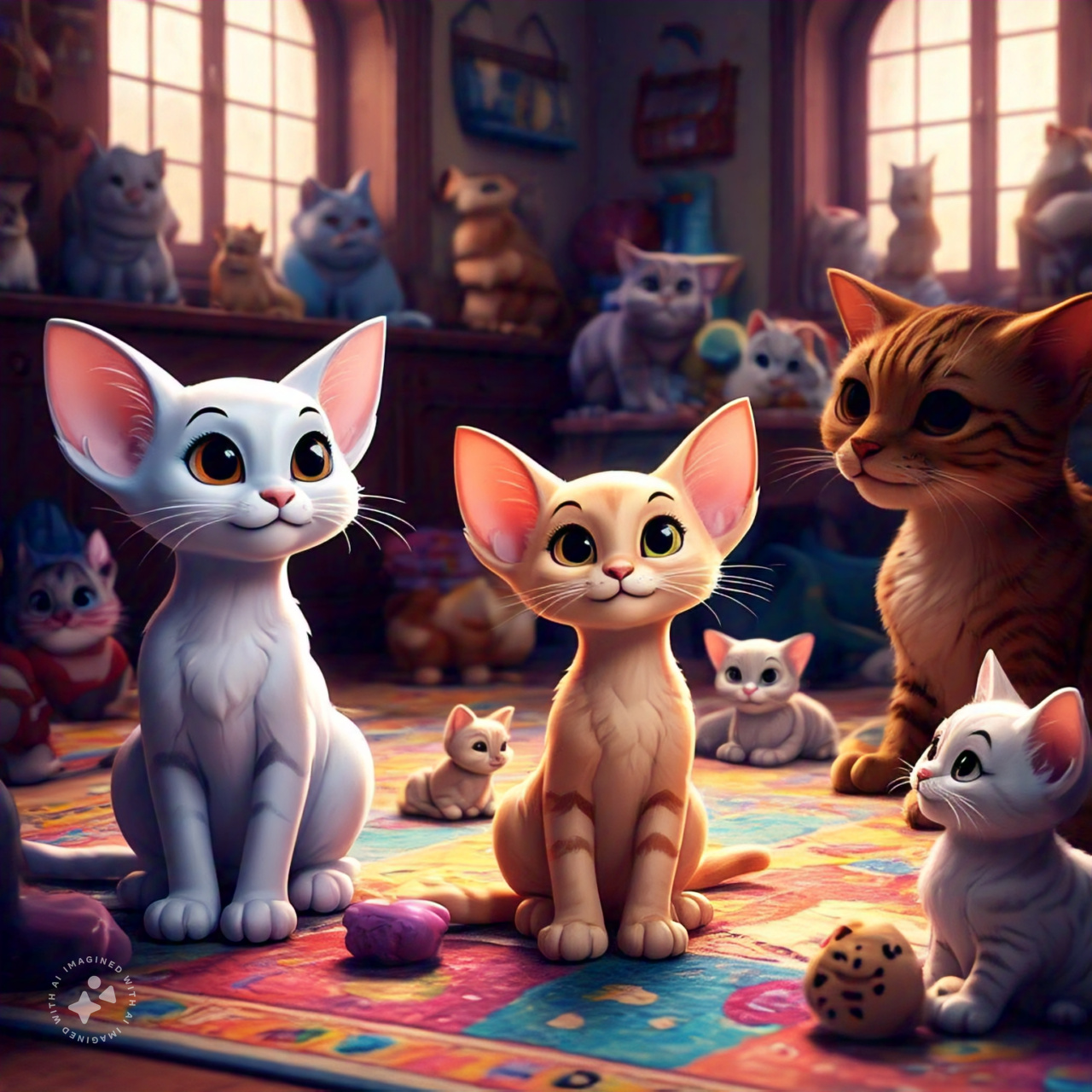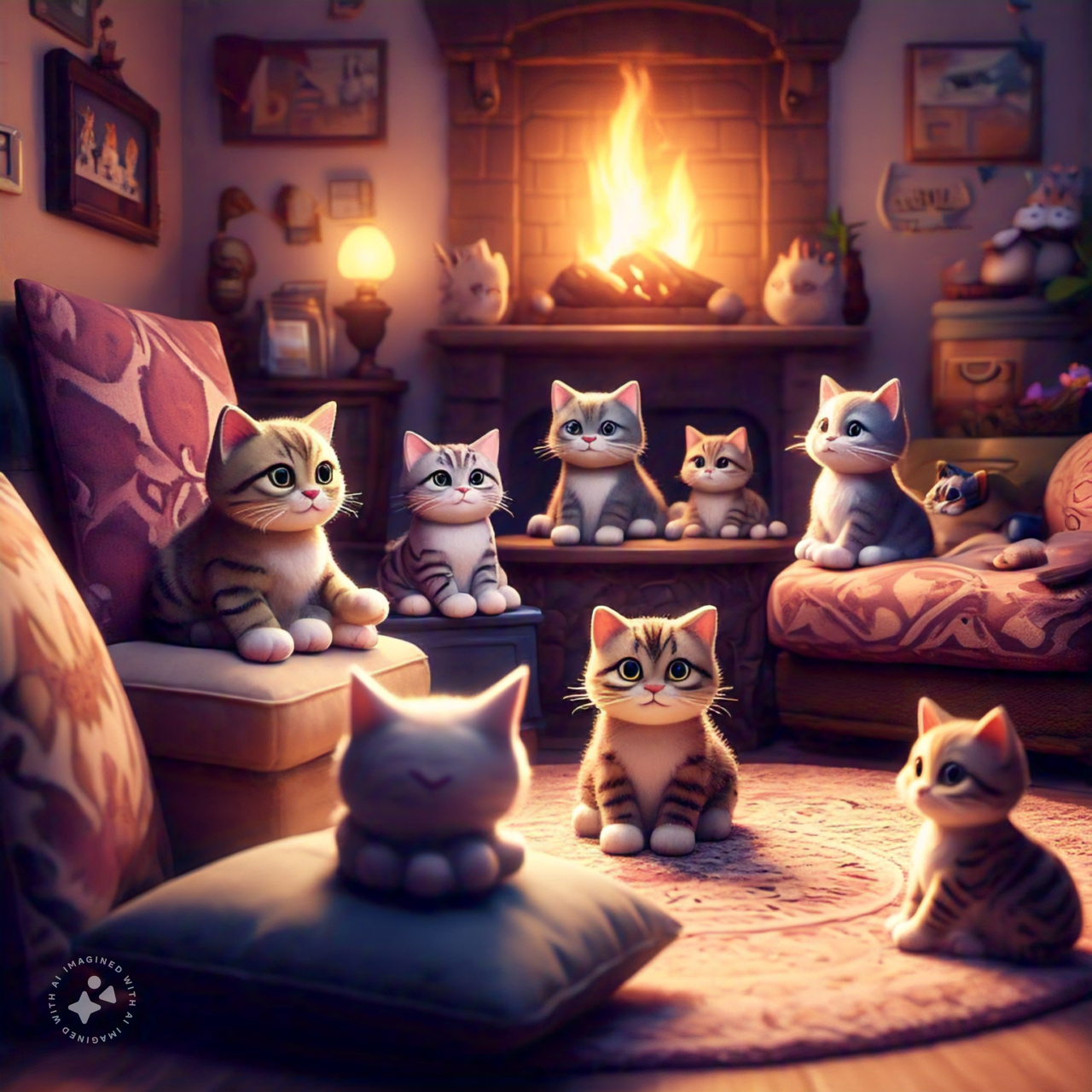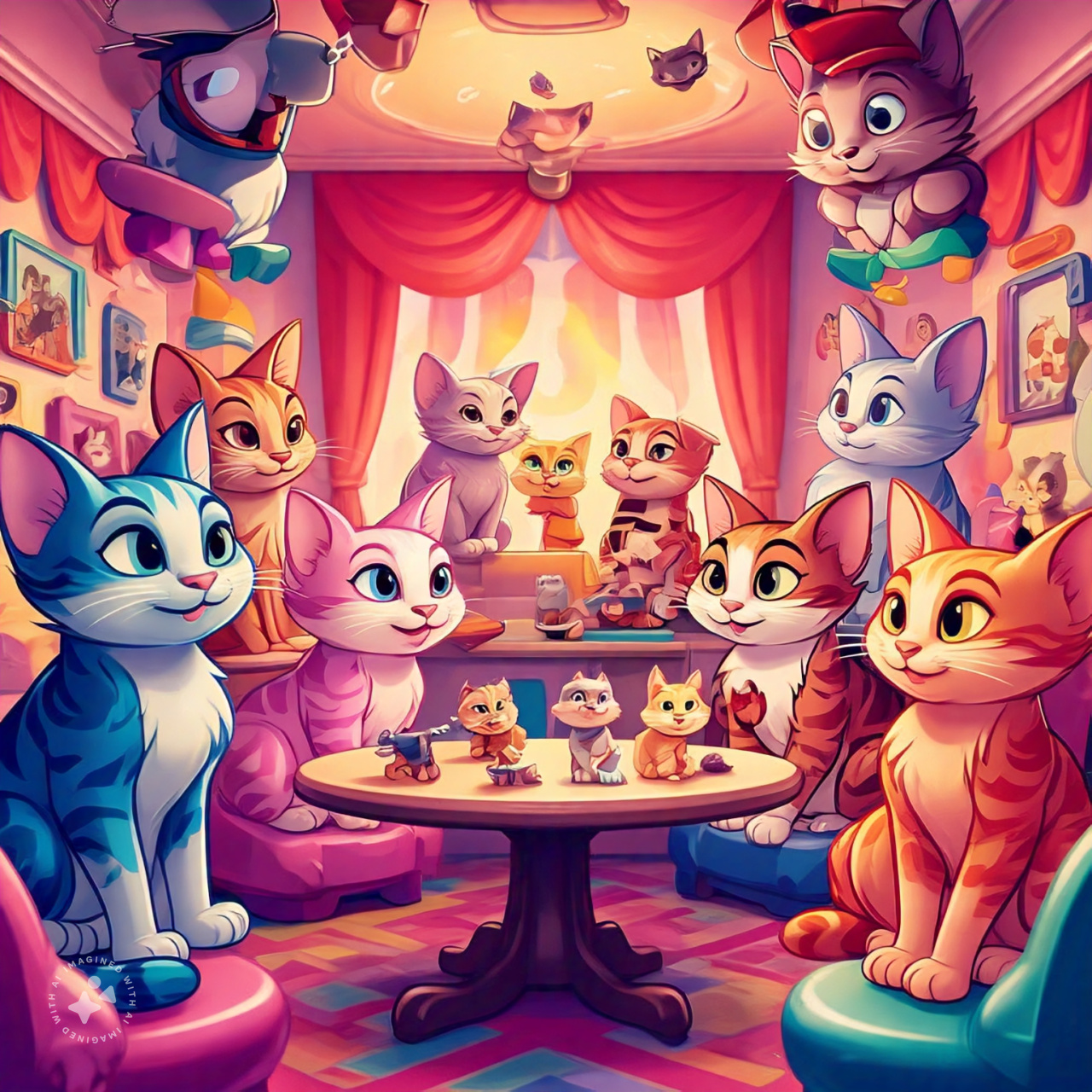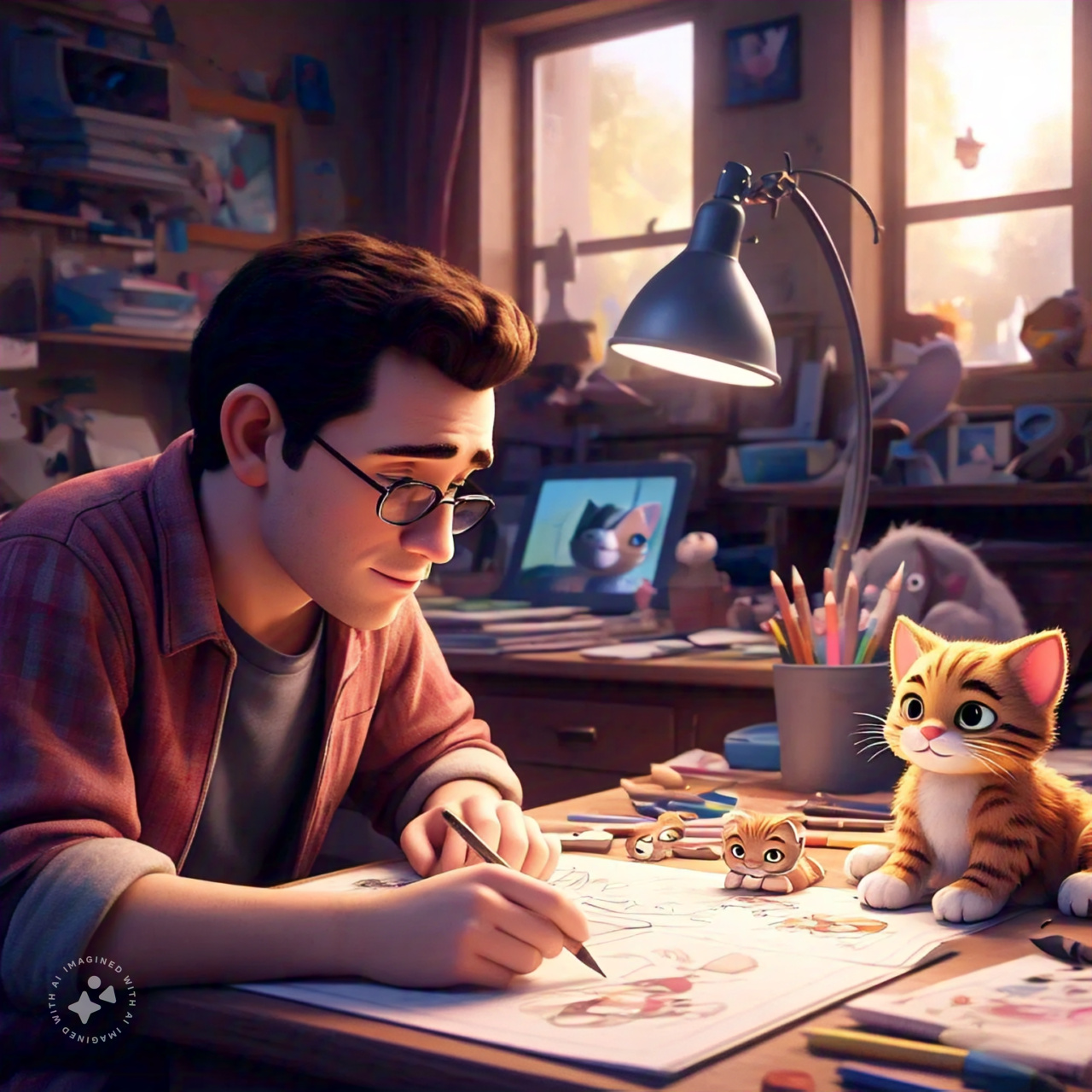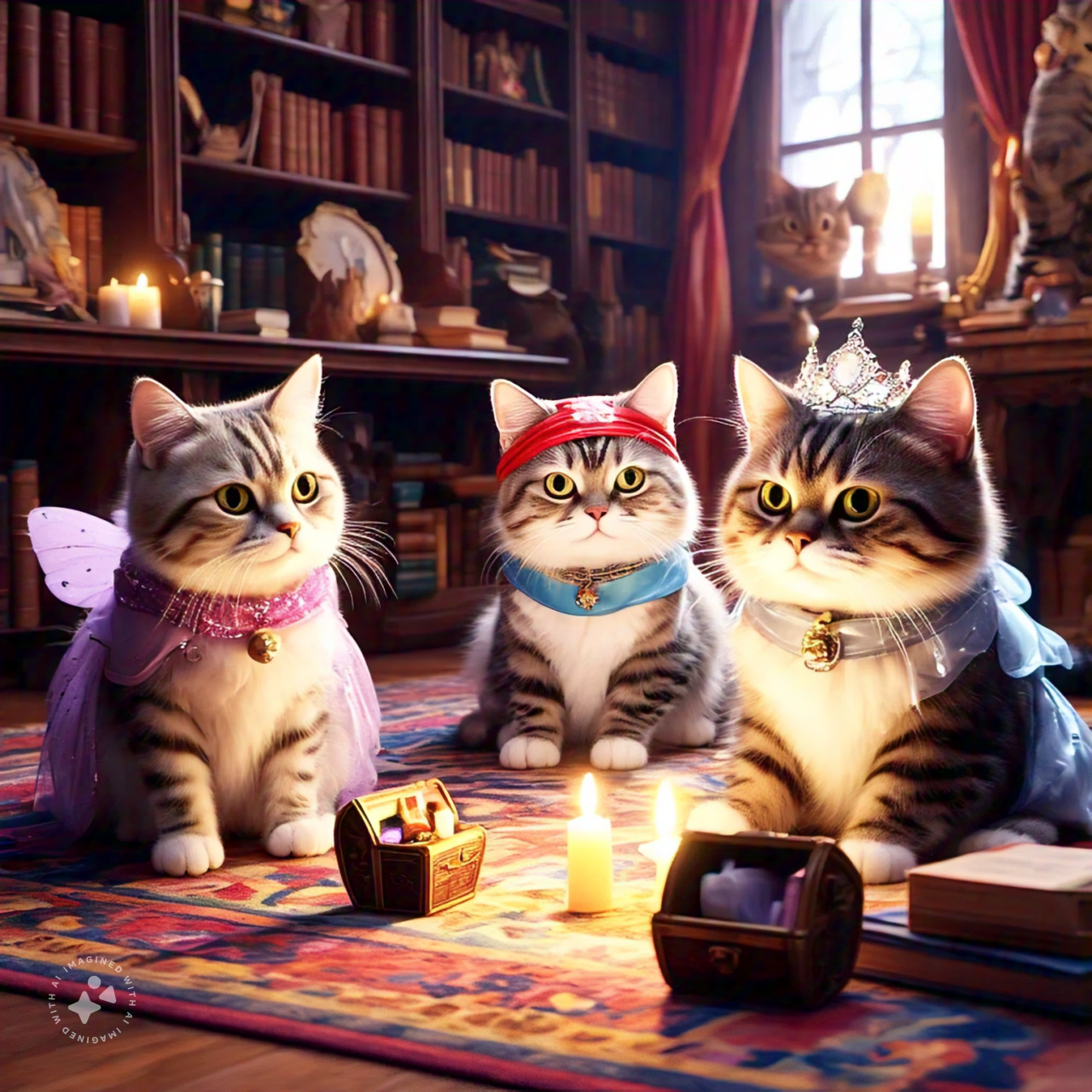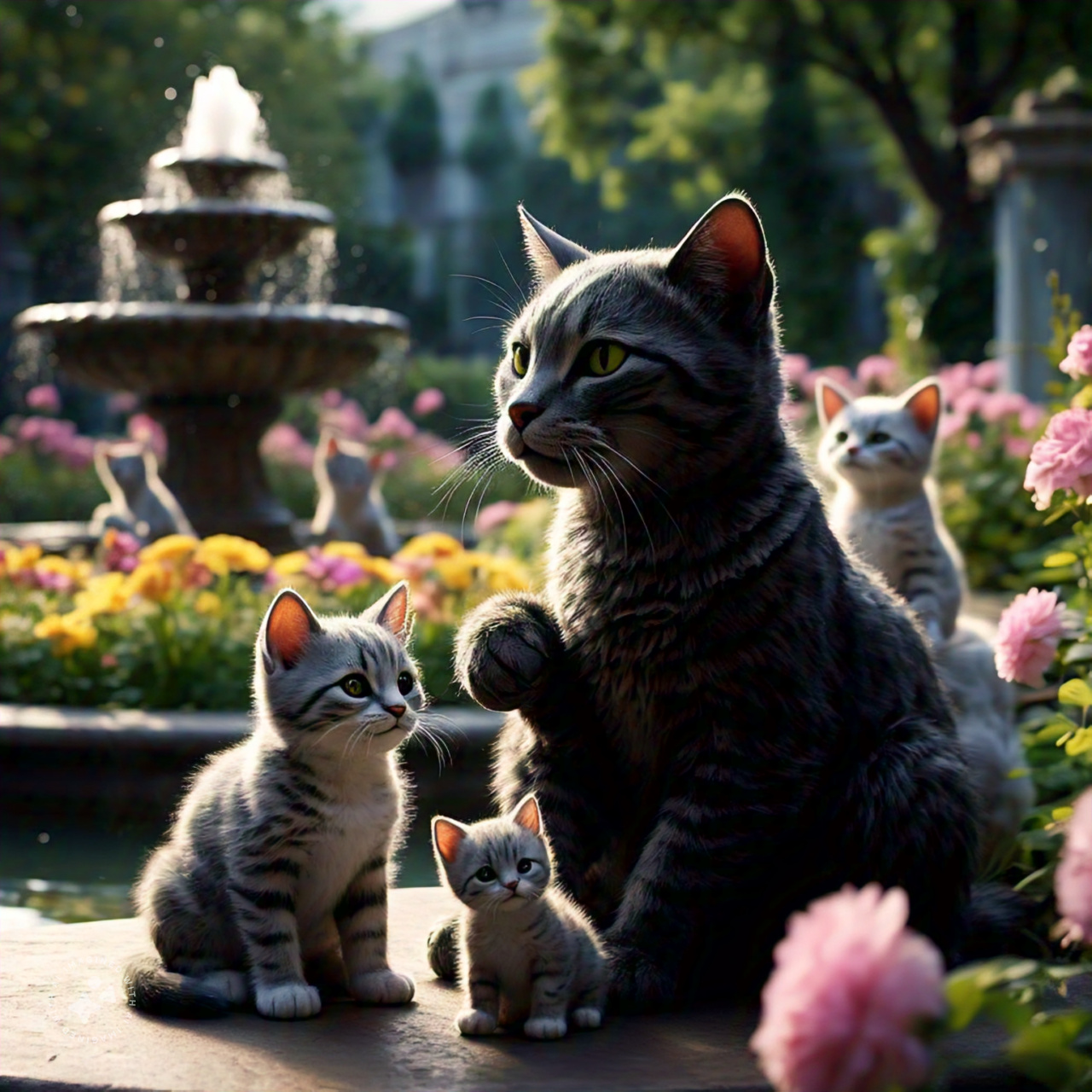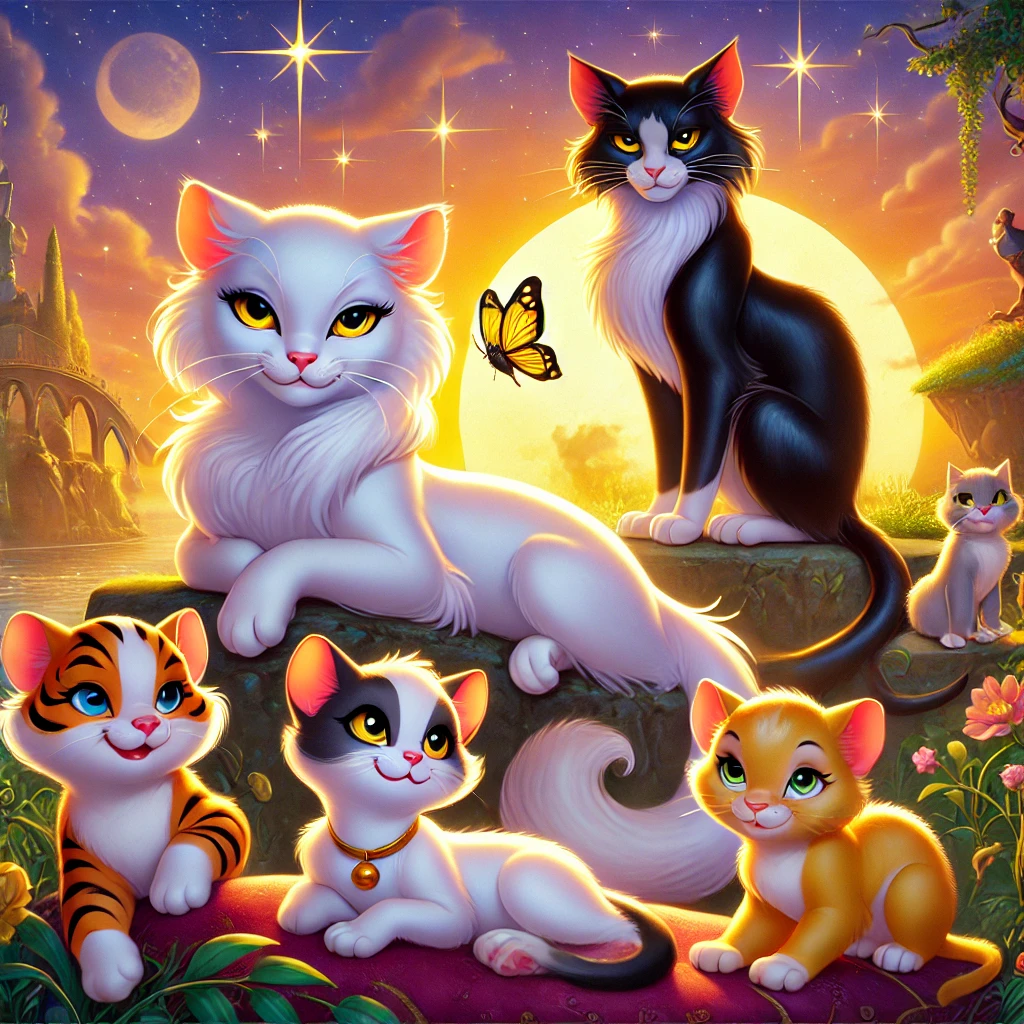Disney’s Animated Cats and the Power of Animation
The enchanting world of Disney animation has gifted audiences with some of the most iconic and beloved characters in cinematic history. Among these characters are the animated cats, creatures that have captivated viewers through their expressive movements, distinct personalities, and clever storytelling. These animated felines often go beyond being mere animals; they are cultural icons, and their creation is a process that involves a delicate balance of artistic skill, technological advancements, and storytelling. In this article, we will explore the process behind Disney’s animated cats, specifically the artistry and creativity that bring these feline characters to life.
Disney’s animated cats have a long history, and they range from the quirky and charming to the majestic and mysterious. Characters like Duchess from The Aristocats and Thomas O’Malley, her street-smart counterpart, stand out not only for their narrative significance but also for the sophisticated animation techniques used to create them. These characters embody the fusion of traditional animation techniques with the innovations that made Disney a household name. Disney’s commitment to bringing personality and depth to animal characters, especially cats, has not only shaped the direction of animated films but also created a lasting impact on animation as an art form.
The process of creating Disney’s animated cats begins long before the first frame is drawn. The development of these characters requires a significant amount of groundwork, involving design, voice acting, movement study, and technology integration. Whether it’s the simple elegance of Duchess or the playful energy of O’Malley, every cat’s creation begins with a deep understanding of the animal’s nature and an artist’s ability to translate that essence into a visual narrative.
Understanding the complexities of the animation process reveals much about how Disney’s animated cats come to life, offering insight into the artistry that makes these characters memorable. This article will delve into the various aspects of creating animated cats, exploring how artists and animators blend the real and the imaginary to craft feline characters that resonate with audiences worldwide.
The Origin of Animated Cats: Crafting Believable Characters
The origins of animated cats at Disney can be traced back to the company’s early days, but it was the introduction of more advanced animation techniques that truly allowed these characters to take shape. Early Disney animated cats were often simple and somewhat caricatured, but they laid the groundwork for the more nuanced depictions that would follow. Over time, Disney’s animation style evolved, and its understanding of animal movement and expression deepened, leading to more sophisticated designs and animations for their feline characters.
One of the first challenges animators faced when creating animated cats was making sure the characters felt believable, even though they were drawn in a two-dimensional space. Cats, like many animals, exhibit complex behaviors that are difficult to capture. Their grace, agility, and independence needed to be conveyed through exaggerated expressions and movements while still maintaining the essence of a real cat. This required animators to study cats extensively, often observing their real-life counterparts to understand how they moved, interacted with their environment, and expressed emotions.
Early in Disney’s history, animators employed a technique called “live-action reference” to aid in this process. For example, animators would observe real cats in action, capturing their movements, interactions with other characters, and body language. This allowed them to replicate the natural movements of cats with greater accuracy, giving their animated characters a sense of realism. In many ways, these early animation studies of cats helped pave the way for more realistic and dynamic animal characters in Disney’s future films.
As technology advanced, animators were able to incorporate more sophisticated tools into their processes, enabling them to refine their techniques. The advent of computer-assisted animation allowed for a more fluid, three-dimensional representation of characters, which was crucial for the creation of realistic cat movements. However, the process was still highly reliant on the artistic talents of the animators. Even with these technological advancements, the fundamental goal remained the same: to make the animated cats believable and relatable to audiences.
The character design process also plays a crucial role in how animated cats come to life. Designers work closely with animators to develop the look and feel of each cat. Their goal is to create a character that reflects its personality, while also making sure it moves and behaves in a way that is true to the real animal. In some cases, designers may exaggerate certain traits or characteristics to emphasize the personality of the cat, giving them a unique flair that sets them apart from other characters. For example, Thomas O’Malley, the streetwise alley cat from The Aristocats, is designed to look scruffy and charismatic, reflecting his easy-going and adventurous nature. Meanwhile, Duchess is drawn with a more refined elegance, reflecting her sophisticated and nurturing personality.
The Role of Technology in Animation: From Hand-Drawn to Computer-Generated Imagery
Over the years, the role of technology in animation has expanded dramatically, changing the way animated characters, including cats, are created. Early Disney films relied heavily on hand-drawn animation, where each frame was drawn by hand and then painted onto cels. This painstaking process gave animators full control over the look and movement of their characters. However, it was also time-consuming and labor-intensive, and as the demand for more complex animations grew, so did the need for more advanced technologies.
The introduction of computer-generated imagery (CGI) in animation brought about a revolution in the industry. While CGI did not entirely replace traditional hand-drawn techniques, it offered a new layer of depth and realism to animated characters, including cats. With the help of CGI, animators were able to simulate lifelike fur textures, shadows, and lighting, making the characters appear more tangible. Additionally, CGI made it possible to create more fluid and natural movements, enhancing the overall realism of the character animations.
In The Aristocats, the integration of new technologies allowed for more detailed and lifelike cat movements. The cats’ fur, for example, was given a more realistic appearance, and their movements were smoother and more natural than ever before. This level of detail not only added to the visual appeal of the film but also contributed to the believability of the characters. Audiences could see the subtle swish of Duchess’ tail or the playful twitch of O’Malley’s whiskers, creating a deeper connection to the characters and their world.
However, even with the rise of CGI, Disney has maintained a balance between technological innovation and the traditional hand-drawn artistry that the company is known for. This blending of techniques allows for the creation of cats that not only look realistic but also possess the charm and personality that Disney characters are known for. While technology has certainly made it easier to create more complex animations, the artistry of the animators is still at the heart of what makes Disney’s animated cats so special.
Character Design and Personality in Disney’s Animated Cats
The success of any animated character, including Disney’s famous cats, begins with an essential process: character design. In this section, we will explore how character design plays a crucial role in shaping the personalities of Disney’s animated cats and why it is so integral to their lasting appeal. The visual design of a character is the first step in communicating its traits, and for Disney animators, this process is highly meticulous. Through character design, artists not only establish a visual style but also hint at the character’s inner world, creating a powerful connection with audiences before the first word is even spoken.
Character design in animation is a reflection of the traits the character embodies. In Disney films, animated cats often personify complex emotions and human-like characteristics, making them relatable to viewers. By examining characters like Duchess, Thomas O’Malley, and the kittens from The Aristocats, we gain insight into how the design process serves as the foundation for their personalities, behaviors, and actions throughout the story.
Visual Aesthetics: Establishing a Character’s Identity
One of the first steps in creating a memorable animated cat is defining its physical appearance. For Disney’s animated cats, this means designing every feature—from fur texture to eye shape, body proportions, and color scheme—in a way that matches the character’s personality and role in the story. Through design, animators convey critical details about the character before the audience hears a single line of dialogue.
Take Duchess, for example. As the refined mother cat in The Aristocats, her design reflects both elegance and maternal warmth. Her fur is soft, smooth, and beautifully detailed, giving her a polished, high-class appearance. Duchess’ face is framed by delicate features, with expressive eyes that convey her intelligence and grace. Her posture and movements are carefully animated to reflect her dignified, poised personality, and even the slight tilt of her head speaks volumes about her nurturing nature. The way her tail curves when she walks and the gentleness with which she holds her kittens further emphasizes her loving, protective side.
In contrast, Thomas O’Malley’s design showcases a more rugged, carefree attitude. His fur is messier, and his face carries an air of casual confidence, highlighted by a slight grin and twinkling eyes. His posture is relaxed, and his movements convey a sense of freedom and adventure. These subtle visual cues help define O’Malley’s role as the street-smart alley cat who’s always ready for a good time but also proves to be surprisingly loyal and compassionate when it counts.
The kittens, meanwhile, each have their own unique traits conveyed through their designs. While they share similarities with their mother in terms of basic features, their personalities shine through in the details. For instance, the kittens’ expressions are more youthful, playful, and innocent, which captures their fun-loving and curious nature. The small differences in their fur, posture, and gaze highlight their individual characteristics, making each one distinct and adding depth to the family dynamic.
Through these character designs, Disney animators masterfully establish personality traits without relying on overt dialogue. A single look, movement, or gesture can communicate volumes about a character’s emotions and motivations. This ability to communicate so much through the visual design is one of the reasons why animated cats, such as Duchess and O’Malley, feel so alive and relatable to audiences.
The Influence of Animation Techniques on Personality
Once the basic character design is established, the next crucial step is bringing these characters to life through animation techniques. The way a character moves, gestures, and reacts within the environment plays a significant role in reinforcing its personality. Disney’s commitment to fluid, expressive animation ensures that each movement reflects the inner life of the character.
Duchess, for example, moves with grace and elegance that mirrors her refined nature. Her actions, such as the way she carries herself or the manner in which she interacts with her kittens, all emphasize her motherly and dignified qualities. The fluidity of her movements, from her soft steps to the gentle swish of her tail, suggests that she is in control of her surroundings and is a calm, composed individual.
O’Malley’s movements, on the other hand, are designed to be quick, unpredictable, and full of energy. His walk is less precise and more carefree, suggesting a character who doesn’t adhere to conventional rules. His leaps and jumps are full of enthusiasm, showing his adventurous side and zest for life. O’Malley’s physicality is a perfect complement to his personality—he’s a cat who enjoys the thrill of the moment and lives life on his own terms.
The kittens’ movements, in contrast, are playful, sometimes awkward, and full of curiosity. They are younger and less experienced than Duchess or O’Malley, and their animation reflects this. Their exaggerated expressions and energetic movements convey innocence and excitement, further reinforcing their roles as the adorable, fun-loving children of the story. Whether they are playfully chasing one another or curiously exploring their environment, their movements capture their youthful exuberance.
These subtle differences in animation are not just about making characters move but about making them feel real and authentic. The way an animated cat moves—whether it’s with the elegance of Duchess or the impetuousness of O’Malley—adds layers to their personalities. Animation techniques, including the use of timing, spacing, and weight, are all key factors in ensuring that each character’s movement is true to its design and personality.
Expression and Communication: Facial Features and Emotions
Beyond body language, one of the most important aspects of character design and animation is the facial expression. The face of an animated cat can convey a range of emotions, from joy and excitement to sadness, frustration, or even sly mischief. Disney animators pay special attention to facial features—especially the eyes, ears, and mouth—ensuring that every emotion is communicated clearly.
Duchess’ eyes, for example, are large and expressive, and they convey warmth and compassion. When she looks at her kittens, there is an undeniable sense of maternal love that shines through her gaze. Her facial expressions often reflect her calm and composed demeanor, but when she is in moments of vulnerability, her softer expressions reveal a deeper emotional range.
O’Malley, on the other hand, is often seen with a mischievous glint in his eyes or a playful smirk. His face expresses his easy-going nature, but when he is protecting or helping others, his expressions shift to show a more sincere and compassionate side. This duality in his expressions adds depth to his character, showing that while he may seem carefree on the outside, he has a strong sense of loyalty and honor.
The kittens’ faces are filled with innocence and wonder. Their wide eyes and joyful expressions often highlight their sense of curiosity, and the simplicity of their emotions makes them endearing to audiences. Whether they are expressing excitement or fear, their faces convey the innocence of youth, which contrasts with the more seasoned personalities of their parents.
Building Connections with the Audience
Character design, animation, and facial expressions all work in harmony to create cats that are relatable and endearing. By focusing on these aspects, Disney animators ensure that their feline characters do more than just exist within the world of the film—they connect with the audience on an emotional level. The design and animation choices made for each character help to create an emotional bond with viewers, making them feel as though they are not just watching animated animals but are actually experiencing the story through the eyes of these beloved characters.
The design of Disney’s animated cats—whether it’s the poised elegance of Duchess, the scruffy charm of O’Malley, or the playful innocence of the kittens—ensures that each cat is both a unique individual and a memorable character. These designs serve as the foundation for the characters’ personalities, helping them resonate with viewers long after the film ends.
The Role of Voice Acting in Breathing Life Into Disney’s Animated Cats
One of the defining aspects of Disney’s animated films is the ability to bring characters to life through voice acting. The art of voice acting is integral to shaping the personality of animated characters, and this is especially true for Disney’s iconic cats. From the sophisticated Duchess to the roguish Thomas O’Malley and the playful kittens, the voices behind these characters contribute to their depth and relatability, making them resonate with audiences in a way that visual design and animation alone cannot.
In this section, we will examine the pivotal role that voice acting plays in animating Disney’s cats, focusing on how voice actors use tone, emotion, and delivery to convey the personalities of these characters. We will also explore how the process of casting, direction, and the relationship between animators and voice actors can influence the final portrayal of animated cats.
The Power of Voice: Shaping Character Identity
Voice acting is not just about providing words for a character; it’s about imbuing them with personality, emotion, and intention. For Disney’s animated cats, the voice actor’s performance helps establish the character’s identity and plays a vital role in connecting the audience to the character’s emotions. The way a character speaks—whether through tone, pacing, or emotional delivery—reveals key aspects of their personality and narrative role.
For Duchess in The Aristocats, voice actress Eva Gabor brought a touch of elegance, sophistication, and maternal warmth to the character. Gabor’s calm, refined tone was the perfect match for the graceful, dignified mother cat who is both a protector and a symbol of class. Duchess’s voice exudes warmth and nurturing, but it also carries an underlying strength. This balance between gentleness and resilience is crucial to the character’s development, and Gabor’s voice acting gives her a timeless charm.
On the opposite side of the spectrum is Thomas O’Malley, voiced by Phil Harris. Harris brought a sense of street-smart charisma and rugged charm to the role of O’Malley, transforming him into a lovable rogue. O’Malley’s voice is playful, relaxed, and laced with humor, capturing the carefree attitude of the alley cat who has a knack for adventure. Harris’s delivery, marked by his smooth, easy-going voice, creates an instantly likable character who balances his playful demeanor with moments of sincerity and depth. His voice adds layers to the character, making O’Malley feel like a three-dimensional figure whose wit and charm mask a heart of gold.
The kittens in The Aristocats were also given distinct voices that reflected their youthful energy, innocence, and curiosity. Voiced by child actors, their voices carry an undeniable sense of excitement and wonder, helping to underscore their playful and mischievous nature. Each kitten has its own personality that shines through in their voice—whether it’s the sweetness of the youngest kitten, or the boldness of the older, more daring sibling. The voices of the kittens create a contrast with the more mature, composed voices of Duchess and O’Malley, highlighting their youthful innocence and sense of discovery.
Voice acting thus serves as the final piece of the puzzle in creating a fully realized character. While the visual design and animation lay the foundation, the voice adds the final layer, allowing the character to come to life in a way that feels complete. The voice provides an emotional connection to the character, helping to convey what might otherwise be lost in animation alone.
The Casting Process: Finding the Perfect Voice
The process of casting the voice actors for animated cats is a delicate and crucial step. Disney’s casting directors carefully select actors who not only possess the vocal talent to bring the character to life but who also have the ability to connect with the personality traits the animators have envisioned. In many cases, the casting of voice actors is a collaborative process that involves input from animators, directors, and other creatives to ensure that the right voice is chosen for the role.
In the case of The Aristocats, Eva Gabor was chosen for Duchess because of her ability to portray elegance and warmth. Gabor’s background in acting, coupled with her natural vocal style, made her the ideal fit for the role of the sophisticated mother cat. Her voice brought a sense of refinement that perfectly matched Duchess’s visual design, elevating the character beyond mere animation to a fully realized, dynamic personality.
Similarly, Phil Harris was selected for the role of Thomas O’Malley because of his extensive experience in both voice work and live-action acting. Harris had a unique ability to infuse his voice with humor and charm, and his familiarity with performing characters who were quick-witted and larger-than-life made him a perfect match for O’Malley. Harris’s delivery in his lines, marked by a slight drawl and a confident, easy-going rhythm, perfectly matched the visual style and animated performance of O’Malley, creating a seamless integration of voice and animation.
For the kittens, Disney’s casting team sought out young child actors who could embody the youthful energy, innocence, and enthusiasm of the characters. Their voices are not only sweet but also full of curiosity, mirroring the playfulness and vulnerability of the characters they portray. The childlike voices of the kittens are endearing, making their interactions with the other characters feel genuine and heartwarming. The casting of these young actors further emphasizes the innocence and joy that the kittens bring to the story.
The casting of voice actors for animated cats, therefore, is a highly strategic process. It requires finding actors who can enhance the visual portrayal of the character and bring out its emotional nuances. In Disney’s case, this casting process has contributed to the iconic performances of characters like Duchess, O’Malley, and the kittens, making them stand out as some of the most beloved animated cats in film history.
Collaboration Between Animators and Voice Actors
While the casting process is essential, it’s the collaboration between animators and voice actors that truly brings the characters to life. The relationship between these two groups is key to ensuring that the voice acting matches the animation, and vice versa. In Disney’s animated films, this collaboration is a seamless process that relies on communication and creative input from all involved parties.
Once the voice actors are cast, they record their lines in a studio, often with the help of a director who ensures that the actors deliver their lines with the right tone and emotion. In many cases, the animators work alongside the voice actors during this process, sometimes adjusting the character’s movements or facial expressions based on how the lines are delivered. This back-and-forth collaboration ensures that the voice and animation are in perfect harmony, creating a cohesive and believable character.
For The Aristocats, this collaboration between voice actors and animators was crucial to the development of each character. The animators would watch the voice actors’ recordings and use them as a guide for shaping the character’s expressions, movements, and actions. In some cases, animators would even adjust the pacing of the character’s movements to better match the rhythm and tone of the voice. This close collaboration between the two creative teams ensures that the voice performance is integrated with the character’s physical performance, making the animation feel more authentic.
Voice Direction and Emotional Range
Voice direction is another key element in the process. The voice director works closely with the voice actors to ensure that they bring the right emotional depth to their roles. For Disney’s animated cats, this often means helping the actors explore a wide range of emotions—from joy and excitement to fear, sadness, and love. A character like Duchess, for example, needs to express both the warmth of a loving mother and the strength of a protector, and the voice direction helps to guide the actor in achieving that balance. Similarly, O’Malley’s character requires moments of comedic levity mixed with sincerity and heart, which the voice direction helps bring to life.
For the kittens, the voice direction ensures that the actors capture their innocence and curiosity while also allowing room for moments of fear or joy. Their voices may be high-pitched and full of wonder, but they also need to convey moments of vulnerability and growth. The guidance from the voice director ensures that these emotional shifts are believable and resonant with the audience.
The Cultural Influence and Enduring Popularity of Disney’s Animated Cats
As we conclude our exploration of the artistry behind Disney’s animated cats, it is important to examine their lasting cultural impact and the reasons why these characters continue to resonate with audiences decades after their original release. Through their unique blend of animation, voice acting, character design, and emotional depth, Disney’s animated cats—particularly those from The Aristocats—have not only become beloved figures in pop culture but also exemplify the lasting appeal of well-crafted animation. Their influence can be seen in various aspects of society, from merchandise and theme park attractions to references in other media.
In this final part, we will delve into how these animated cats have shaped popular culture, why they continue to be relevant today, and the broader cultural significance they hold within the Disney legacy. By examining their continued popularity and the ways in which The Aristocats and its feline stars have become symbols of creativity, fun, and emotion, we gain a deeper understanding of the lasting power of Disney animation.
The Enduring Appeal of Disney’s Animated Cats
One of the most striking elements of Disney’s animated cats is their ability to transcend generations. The Aristocats was released in 1970, yet its characters, particularly Duchess and Thomas O’Malley, remain iconic figures in the Disney pantheon. The film’s blend of charming animation, heartwarming storytelling, and engaging characters ensures that it continues to captivate audiences, both young and old.
The timeless nature of these characters speaks to the quality of their design, personality, and the universal themes they represent. Duchess, as the elegant mother, O’Malley, as the lovable rogue, and the kittens, as symbols of innocence and joy, reflect archetypes that are deeply embedded in human storytelling. These characters represent relatable, human qualities—love, adventure, responsibility, and playfulness—that resonate across time and culture. The way these characters interact with one another reflects universal truths about family, loyalty, and growth, making them feel as relevant today as they did upon their release.
Moreover, the aesthetic appeal of The Aristocats continues to draw new generations of fans. The film’s rich color palette, charming character designs, and lively animation remain visually striking, ensuring that its aesthetic qualities remain fresh and captivating. While animation techniques have evolved over the years, the timeless artistry of The Aristocats ensures its continued relevance in today’s visually driven media landscape.
Disney’s Cats in Pop Culture
Beyond their initial success as part of The Aristocats, Disney’s animated cats have infiltrated various facets of pop culture, from merchandise and music to references in other media. Duchess, Thomas O’Malley, and the kittens are often seen in Disney merchandise, appearing on everything from plush toys to clothing, bedding, and accessories. Their likenesses adorn countless products aimed at children and collectors alike, ensuring that they remain visible and beloved parts of the Disney universe.
The song “Everybody Wants to Be a Cat,” featured in The Aristocats, has also become a cultural touchstone. Its catchy melody and jazz-infused style have made it a favorite among Disney fans, further cementing the film’s place in popular culture. The song is often included in Disney playlists, performed in various productions, and referenced in other media, keeping the spirit of the film alive long after its original release. The catchy tune and whimsical lyrics embody the playful, carefree nature of the cats, making it a lasting symbol of the film’s charm.
In addition to merchandise and music, the characters of The Aristocats have also made appearances in other Disney media. For example, Thomas O’Malley has occasionally appeared in Disney parades, theme park events, and special television programs. These appearances introduce the characters to new audiences, while also allowing long-time fans to reconnect with their beloved feline heroes. The continued presence of Duchess, O’Malley, and the kittens in these spaces ensures that their impact is felt across multiple generations and continues to be shared with viewers who may not have seen the original film.
The Influence of Disney Cats in Animation and Media
Disney’s animated cats have not only made a significant impact on popular culture but have also influenced the broader world of animation. In the decades following The Aristocats, the success of Disney’s feline characters served as a model for other animated films and studios. Characters like Thomas O’Malley and Duchess helped set the stage for future Disney animated characters who would combine human-like emotions with animal traits. The blend of humor, heart, and adventure in these characters became a hallmark of Disney’s approach to animation, influencing films that followed, such as The Lion King, Lady and the Tramp, and Bolt.
In addition to inspiring other Disney films, the characters of The Aristocats also contributed to the development of animated cats in other media. The portrayal of these cats as more than mere animals—imbued with personality, wit, and emotional depth—became a template for many animated cats in later films and television shows. These cats, much like Duchess and O’Malley, serve as beloved archetypes that reflect the best qualities of their human counterparts while remaining distinctively animalistic in their behavior.
The success of Disney’s animated cats can also be seen in the influence they have had on the animation industry’s approach to character design. The way Disney animators crafted these characters—focusing on detail, movement, and emotional resonance—has informed the way that other studios approach their own animated characters. The fusion of character design, voice acting, and animation in The Aristocats remains a gold standard in the industry, setting the bar for the creation of memorable, multi-dimensional animated characters.
The Timeless Themes and Values in The Aristocats
At the heart of the enduring popularity of Disney’s animated cats is the timelessness of the themes explored in The Aristocats. Family, friendship, love, and loyalty are central to the story, making it universally relatable and emotionally resonant. Duchess, Thomas O’Malley, and the kittens’ journey is a story of personal growth, bonding, and overcoming adversity—values that continue to strike a chord with audiences of all ages.
The way the characters interact—Duchess’s nurturing care for her kittens, O’Malley’s growth as a protector and father figure, and the kittens’ exploration of the world around them—reflects the importance of relationships in life. These themes are universal and not bound by time or place, which is why The Aristocats continues to resonate with audiences even decades after its release.
Moreover, the film’s celebration of music, specifically jazz, provides another layer of cultural significance. Jazz music plays a pivotal role in shaping the film’s atmosphere, bringing a sense of freedom, energy, and fun to the characters and their world. This musical choice reflects the themes of individuality and expression, which are integral to the story’s message. The iconic song “Everybody Wants to Be a Cat” serves as a perfect example of how music and animation can work together to amplify the film’s themes and make them unforgettable.
The Legacy of Disney’s Animated Cats
Ultimately, the lasting popularity of Disney’s animated cats is a testament to the power of animation as a storytelling medium. Through their careful design, engaging personalities, and emotional depth, characters like Duchess, Thomas O’Malley, and the kittens have left an indelible mark on audiences worldwide. They continue to be cherished by fans of all ages and remain an important part of Disney’s rich legacy of animated films.
The influence of these cats can be seen not only in merchandise, music, and media references but also in the way they have inspired future generations of animators, voice actors, and storytellers. Their continued presence in popular culture and their ability to transcend generations demonstrate the timeless appeal of Disney animation. As long as audiences continue to fall in love with Duchess, O’Malley, and the kittens, the legacy of Disney’s animated cats will remain firmly intact.
Conclusion: The Unbreakable Bond Between Disney’s Cats and Their Audiences
Disney’s animated cats, especially from The Aristocats, represent more than just animated characters—they embody timeless values and evoke deep emotional connections. From their inception through design, voice acting, and animation, to their lasting influence on popular culture and animation, these cats have become beloved symbols of creativity, humor, and heart. Their ability to transcend generations, impact pop culture, and remain relevant in today’s world is a testament to the artistry and enduring power of Disney animation. As long as there are fans who cherish the charm of Duchess, Thomas O’Malley, and the kittens, their legacy will continue to grow, ensuring that Disney’s animated cats remain icons of both the animation industry and global pop culture.
